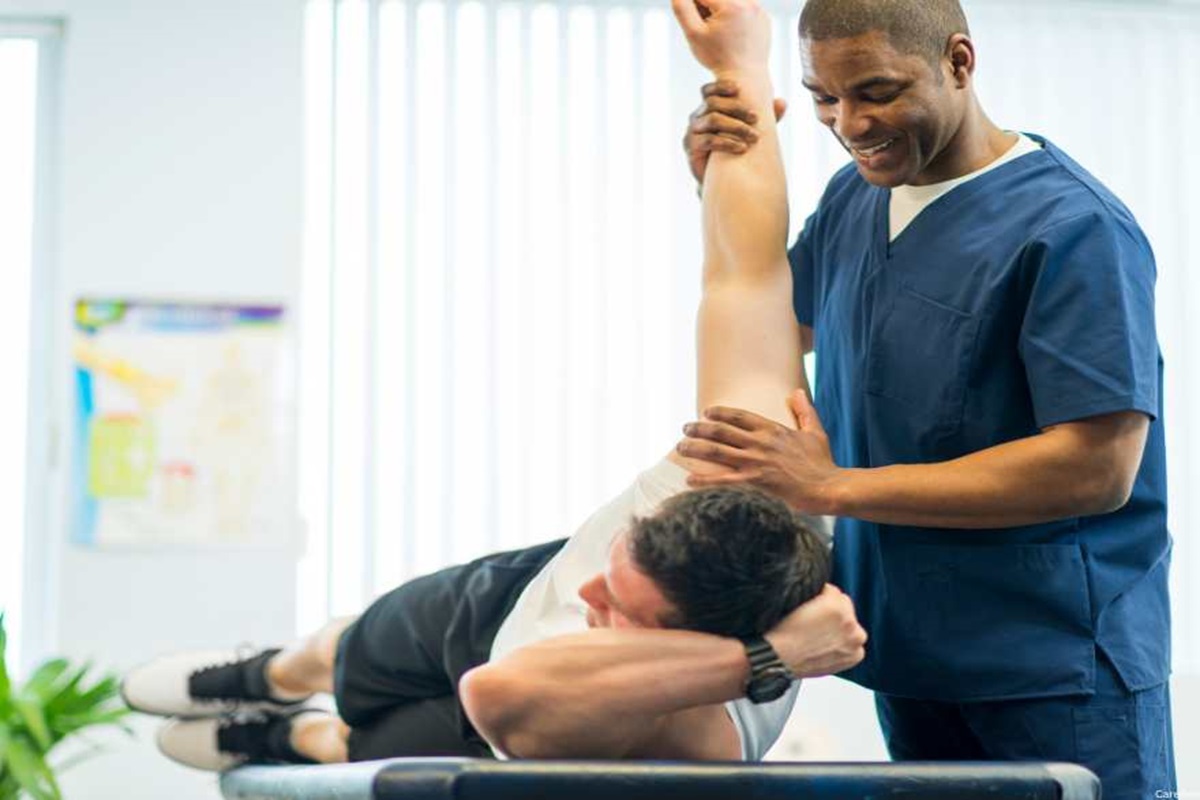When it comes to rehabilitation, two fields often cause confusion: occupational therapy vs physical therapy. While both are essential in helping individuals recover and regain function, they serve distinct purposes. Understanding these differences can help patients choose the right therapy for their needs. If you’ve ever wondered whether you need occupational vs physical therapy, this guide will clear up the confusion and provide insights into how each can benefit you.
Beyond patient care, career opportunities in both fields are growing, with increasing demand for physical therapists and demand for occupational therapists across various rehabilitation settings such as long-term care facilities, private practices, and inpatient rehabilitation centers.
Occupational Therapy vs. Physical Therapy: What Sets Them Apart?
At their core, physical vs occupational therapy differ in their job duties. Physical therapy primarily addresses movement impairments, injury rehabilitation, and chronic pain management through therapeutic exercise techniques and manual therapy. Occupational therapy, on the other hand, focuses on activities of daily living (ADLs), such as self-care activities, cognitive rehabilitation, and the use of adaptive equipment and assistive devices to help individuals regain independence.
Both professions involve patient education, functional abilities assessment, and work with an interprofessional team that includes primary care providers, specialists, and movement specialists. They develop comprehensive treatment plans using a holistic approach to improve patient outcomes.
How Are Occupational and Physical Therapy Similar?
Despite their differences, occupational therapy vs physical therapy share common elements:
- Both play a critical role in rehabilitative healthcare, working to improve a patient’s functional abilities.
- Both involve hands-on therapy and therapeutic exercises to enhance recovery.
- Both collaborate with an interprofessional team to provide personalized intervention plans.
- Both require advanced education and ongoing training to specialize in areas like neurological conditions, pediatric conditions, pain neuroscience education, and hand therapy.
The benefits of physical and occupational therapy in postacute care settings have been well-documented. A study analyzing over 1.4 million Medicare cases found that patients receiving therapy in these settings experienced significant functional improvements. This research underscores the effectiveness of physical rehabilitation and occupational therapy in enhancing patient outcomes, especially after surgeries or serious illnesses.
What Does a Physical Therapist Do?
Physical therapists (PTs) are movement specialists who help individuals recover from injuries, surgeries, and chronic conditions that impact mobility and function. Their work focuses on improving range of motion, strength, and flexibility while reducing pain and inflammation. PTs develop personalized treatment plans that incorporate therapeutic exercises, manual therapy, and pain neuroscience education to enhance patient outcomes. Whether recovering from an accident or managing a long-term condition, physical therapy plays a crucial role in restoring independence and preventing further complications.
Goals of Physical Therapy
Physical therapy plays a vital role in helping patients regain movement, strength, and independence. Physical therapists design tailored treatment plans to address specific issues related to mobility, pain, and recovery. Whether you’re recovering from surgery, managing chronic pain, or working on regaining motor function, physical therapy can help you achieve your goals. Some key goals of physical therapy include:
- Improving range of motion, strength, and mobility.
- Reducing pain and inflammation through manual therapy and therapeutic exercises.
- Enhancing patient outcomes for those with movement impairments, neurological conditions, or neuro-musculo-skeletal system disorders.
- Providing rehabilitative treatment and physical rehabilitation to prevent future injuries.
When Do You Need Physical Therapy?
Physical therapy can benefit individuals who are recovering from injuries, surgeries, or managing chronic conditions. If you’re dealing with pain, mobility challenges, or recovering from a procedure, physical therapy can be a key part of your recovery. You may benefit from PT if you:
- Have experienced a sports injury or accident-related injury rehabilitation.
- Need pre- and post-surgical care to regain mobility.
- Suffer from chronic pain management issues like arthritis.
- Have conditions affecting pelvic health, gross motor skills, or fine motor skills.
What to Expect in Physical Therapy Sessions
Physical therapy sessions are structured to assess your specific needs and guide you through a tailored recovery plan. The therapist will work closely with you to develop a comprehensive treatment plan that aligns with your goals and addresses your concerns. A typical PT session includes:A functional abilities assessment to determine the best treatment plans.
- Exercises designed to improve gross motor skills and range of motion.
- Pain neuroscience education to help patients understand and manage their pain.
- Therapeutic exercise techniques to enhance mobility and prevent injuries.
Where Can You Get Physical Therapy?
Physical therapy is widely available across various rehabilitation settings, making it easier for patients to access the care they need. Whether you’re seeking rehabilitation in a specialized facility or need a more personalized setting, physical therapy services are offered in:
- Long-term care facilities
- Private practices
- Professional Physical Therapy in Colorado Springs
- Hospitals and inpatient rehabilitation centers
What Does an Occupational Therapist Do?

Occupational therapists (OTs) help individuals regain the skills needed for everyday tasks, also known as activities of daily living (ADLs). Unlike PTs, who focus on movement rehabilitation, OTs work on functional abilities assessment, cognitive rehabilitation, and fine and gross motor skills to improve self-care activities and overall independence. They often incorporate assistive devices, adaptive equipment, and therapeutic exercises to help patients overcome cognitive or developmental disabilities, motor-function challenges, and mental health disorders. Whether working with children, the elderly, or individuals recovering from injury, OTs take a holistic approach to enhance a person’s quality of life.
Goals of Occupational Therapy
Occupational therapy is designed to help individuals regain the skills needed to perform daily activities with greater ease and independence. By focusing on both physical and cognitive challenges, occupational therapists provide personalized strategies to help patients enhance their functional abilities in everyday life.
Occupational therapists focus on helping patients regain independence by:
- Improving fine and gross motor skills to support activities of daily living (ADLs).
- Teaching cognitive rehabilitation strategies to assist with mental health disorders and developmental conditions.
- Using assistive devices and adaptive equipment to promote independence promotion.
When Do You Need Occupational Therapy?
Occupational therapy can be beneficial for individuals of all ages who face challenges in performing daily activities due to physical, cognitive, or mental health conditions. Whether recovering from an injury, managing a disability, or needing support with workplace adaptations, OT can provide valuable interventions to improve overall quality of life.
You may need OT if you:
- Have difficulty with daily living activities due to injury, illness, or cognitive or developmental disabilities.
- Require mental healthcare support for conditions impacting functional abilities.
- Need hand therapy for dexterity and strength improvement.
- Need workplace adaptations to enhance performance.
What to Expect in Occupational Therapy Sessions
Occupational therapy sessions are tailored to meet each patient’s specific needs, ensuring they receive the right tools and techniques to improve their independence. Sessions typically involve a combination of therapeutic exercises, assistive devices, and cognitive strategies to address both physical and mental challenges.
OT sessions typically include:
- Assessments of daily challenges and functional needs.
- Training in self-care activities and motor-function challenges.
- Mental health understanding and cognitive skill-building exercises.
- Personalized intervention plans incorporating adaptive equipment and assistive devices.
Where Can You Get Occupational Therapy?
Occupational therapy services are offered in a wide range of settings, ensuring accessibility for individuals who require support in regaining independence. Whether in medical facilities or specialized therapy centers, OTs work with patients in various environments to maximize their progress.
OT services are available in:
- Hospitals
- Rehabilitation settings
- Occupational therapy settings like mental healthcare centers and pediatric clinics
- Private practices and self-employment
Misconceptions About Occupational and Physical Therapy
Many people misunderstand the roles of occupational vs physical therapy, leading to confusion about which one they need. While both focus on rehabilitative healthcare, they have distinct goals and approaches. Below are some common misconceptions that often arise when comparing physical vs occupational therapy:
- “Occupational therapy is only for workplace injuries.” False! OT helps with all aspects of daily living activities.
- “Physical therapy and occupational therapy are the same.” Not true—PT focuses on movement impairments, while OT emphasizes functional abilities.
- “You must be injured to need therapy.” Both physical rehabilitation and occupational therapy can be used preventatively.
Choosing the Right Therapy for Your Needs
The demand for occupational therapists and demand for physical therapists is rapidly increasing due to their essential roles in rehabilitative healthcare. According to the U.S. Bureau of Labor Statistics, the field of occupational therapy is projected to grow by 18% and physical therapy by 22% from 2018 to 2028. This rapid job growth highlights the need for professionals who can help patients regain their functional abilities, making both fields excellent career opportunities.
With this high demand, both professions offer diverse work settings, including private practices, long-term care facilities, and inpatient rehabilitation centers. The opportunity for self-employment is also growing, allowing therapists to build their own practices and tailor their services to specific patient needs.
How Backcountry Physical Therapy Can Help You Recover Faster

Recovering from an injury or managing a chronic condition requires a personalized and strategic approach. At Backcountry Physical Therapy, we specialize in comprehensive treatment plans that focus on injury rehabilitation, movement impairments, and chronic pain management. Our expert movement specialists use a multidisciplinary approach to ensure you regain strength, mobility, and confidence in your daily activities. Physical therapy is effective for chronic pain management, helping patients achieve long-term relief through targeted interventions.
Our Proven 4-Step Physical Therapy Process
We take a holistic approach to rehabilitation, ensuring that each patient receives individualized care tailored to their specific needs.
Step 1: Book Your First Appointment
Getting started is simple—just call or book online to schedule your first visit. We’ll match you with a specialist who understands your condition and goals.
Step 2: Comprehensive Evaluation & Goal Setting
We conduct a thorough functional abilities assessment to identify movement impairments, range of motion limitations, and strength deficits. This helps us develop a customized treatment plan that aligns with your recovery goals.
Step 3: Personalized Therapy Plan for Maximum Results
Your therapy sessions will include:
- Therapeutic exercise techniques to improve strength and flexibility.
- Hands-on therapy and manual therapy to alleviate pain and enhance mobility.
- Pain neuroscience education to help you understand and manage chronic pain effectively.
- Pre- and post-surgical care to optimize recovery and prevent complications.
Step 4: Recover, Prevent, and Perform Better
Our goal isn’t just recovery—it’s long-term success. We equip you with:
- Injury prevention strategies to reduce the risk of future issues.
- Personalized home exercise programs to maintain progress.
- Education on rehabilitative care to ensure lasting improvements in mobility and function.
Conclusion
Understanding the differences between physical therapy vs occupational therapy ensures you get the right care for your needs. Whether you need pain relief, improved mobility, or assistance in daily activities, both OT and PT play essential roles in rehabilitative healthcare. By choosing the right therapy, you can regain independence, enhance your quality of life, and achieve long-term wellness. If you’re unsure which therapy suits your condition best, consulting with a rehabilitative healthcare specialist can guide you toward the most effective treatment plan.
FAQs
What is the main difference between physiotherapy and occupational therapy?
Physiotherapy (or PT) focuses on movement impairments, strength, and pain relief, while OT helps individuals regain the ability to perform daily activities.
What is an example of occupational therapy?
An example would be an OT helping a stroke survivor regain the ability to dress, cook, or write using adaptive equipment and assistive devices.
Why PT is better than OT?
Neither is “better” than the other—it depends on your needs. PT is ideal for chronic pain management and mobility, while OT is better for daily function and independence promotion.



